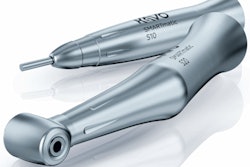
Can fluoride varnish prevent demineralization of teeth following interproximal reduction? To find out, researchers put two varnishes to the test, running dozens of reduced dental surfaces through a simulated oral environment.
Profluorid varnish (Voco) significantly outperformed both untreated teeth and teeth treated with Clinpro White varnish (3M) in a study published by PLOS One (April 21, 2017). The authors suggested that fluoride varnish may be an effective way to prevent demineralization following interproximal reduction.
"From a clinical point of view, the use of fluoride varnish could be more effective, given that ... new interdental contact points are soon established, limiting toothpaste and dental cream access to the reduced interproximal surfaces," the authors wrote. "But fluoride varnish will remain adhered to the surface, maintaining its contact with the enamel for longer than toothpaste or dental cream."
The authors included Ascensión Vicente, DDS, PhD; Antonio José Ortiz Ruiz, DDS, MD, PhD; and Luis-Alberto Bravo-González, DDS, MD, PhD, who all contributed equally on the study. The authors are from the University of Murcia in Spain.
Profluorid helps to prevent demineralization
While interproximal enamel reduction helps treat overcrowding, it also leaves enamel at risk for demineralization and plaque accumulation. Previous research has shown that fluoride varnish may prevent these adverse effects. Therefore, the researchers from Spain put two common fluoride varnishes to the test to see if they changed the levels of calcium and phosphorous of enamel after reduction and demineralization.
The researchers began with 69 extracted lower permanent incisors. They removed 0.5 mm from 62 of the incisors with a safe-tipped bur, and left the remaining seven unreduced. They then sectioned the teeth vertically and horizontally, resulting in 138 dental surfaces, most with interproximally reduced edges but some with intact enamel as a control.
The researchers split the surfaces into six groups, including one group treated with Profluorid varnish and another treated with Clinpro White varnish (see the chart below for the other four groups). Four of the test groups, including the two groups with fluoride varnish, were cycled between an artificial saliva solution and a demineralization solution for eight days. The surfaces were placed in the demineralization solution for two hours three times per day to simulate a typical oral environment while also ensuring complete pH recovery.
| Variables in fluoride varnish test | ||
| Group | Stored in artificial saliva for 8 days | Cycled between artificial saliva and demineralization solution for 8 days |
| Group 1: Intact enamel | X | |
| Group 2: Intact enamel | X | |
| Group 3: Interproximally reduced enamel | X | |
| Group 4: Interproximally reduced enamel | X | |
| Group 5: Interproximally reduced enamel + Profluorid | X | |
| Group 6: Interproximally reduced enamel + Clinpro White | X | |
After eight days, the researchers scanned each surface with energy-dispersive x-ray spectrometry to calculate the weight of calcium, phosphorus, and fluoride in each surface. They also examined the surfaces under scanning electron microscopy.
The group treated with Profluorid before demineralization had significantly more calcium than the group without any fluoride varnish and those treated with Clinpro White. In addition, unreduced teeth had slightly more calcium than those that were interproximally reduced, and the researchers found no significant differences in phosphorous among any of the groups.

"Perhaps the present findings can be explained by the different viscosity of the varnishes evaluated," the authors wrote. "The greater fluidity of Profluorid could favor both more adhesive contact with the enamel and the formation of a more even and homogenous layer of varnish."
The Clinpro White group was the only group to have detectable fluoride, with fluoride visible on 65% of the enamel surface. However, the group also had signs of demineralization, suggesting that the fluoride was not captured by the enamel.
Need to test other types of varnish
The authors did not declare any competing interests or specific funding that may have influenced the results. They noted that future in vivo studies are needed to confirm their results, as laboratory studies cannot fully mimic the oral environment. Having studies that test more types of fluoride varnish also would be beneficial.
Nevertheless, the results suggest that Profluorid varnish may help prevent demineralization for teeth that have been interproximally reduced, a finding that aligns with previous research.
"The use of Profluorid after interproximal dental enamel reduction of incisors prevents the loss of calcium provoked by demineralization cycles," the authors concluded. "Profluorid application could act as a 'barrier' against the demineralization processes suffered by enamel following interproximal reduction."



















